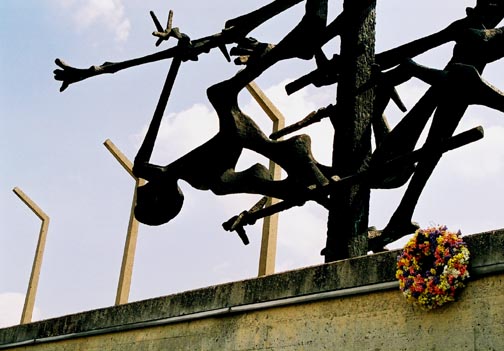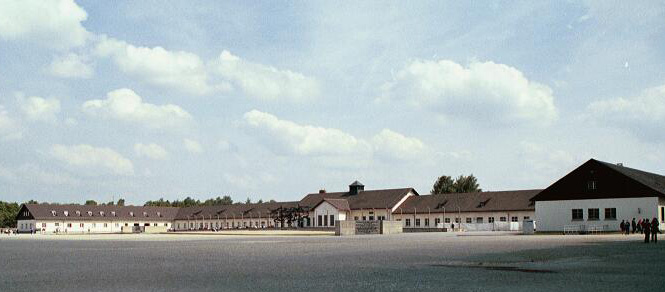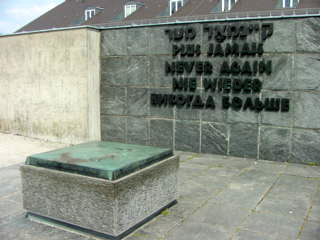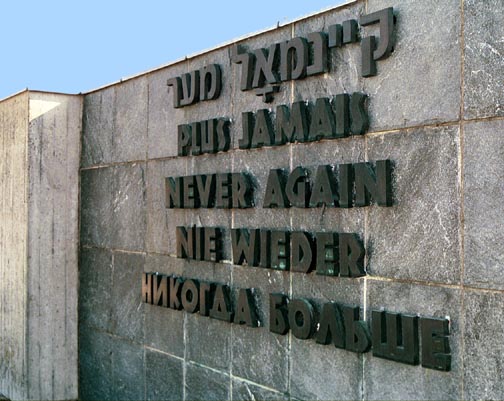International Monument at Dachau The International Monument at the Dachau Memorial Site was formally dedicated in September 1968. The photo above shows the sculpture created by Nandor Glid. The sculpture is made of dark bronze. It features short strands of barbed wire on which skeletons are hanging with their heads dangling sharply. On either side of the sculpture are concrete fence posts which closely resemble the ones actually used to support the barbed wire fence around the camp. Underneath the sculpture are the dates 1933 - 1945, the years that the camp was used as a concentration camp for anti-Nazis.  The Dachau camp was liberated by American troops on April 29, 1945. Between June 1945 and August 1948, the former concentration camp was used as a prison for suspected German war criminals, and from 1948 until late 1965, it was a camp for homeless German refugees who had been expelled from the Sudetenland in what is now the Czech Republic. By 1960, construction had begun on the Memorial Site in honor of the anti-Nazis, while the homeless Germans were still living in the old barracks. A competition among artists who were concentration camp survivors was announced on New Year's day in 1959 to find a suitable design. Forty-five of the 63 entries were exhibited in November 1959 at the Ministry for Health and Family in Brussels. The final decision to choose the entry by Nandor Glid was made by Albert Guérisse, who was imprisoned at Dachau after he was captured while working as a spy for the British SOE. Guérisse was the President of the International Committee which planned the Memorial Site.  From below, you can see that the sculpture is not flat, but has a depth of about four feet. Notice the hands of the skeletons which resemble the barbs on a barbed wire fence. The sculpture is approximately 48 feet wide and 19 feet tall. It symbolizes the emaciated bodies of the prisoners who died of starvation and disease in the camp.  The International monument is made up of several separate parts, which were placed on a huge field of gravel in front of the former administration bulding, which is shown in the photo above. On the west side, which is on the right in the photo above, is a wall whose inscription in English reads "May the example of those who were exterminated here between 1933 and 1945 because they resisted nazism help to unite the living for the defense of peace and freedom and in respect for their fellow men." In the photograph below you can see the roof of the east wing of the administration building behind a short wall that is part of the International Monument on the east side of the field of gravel. The letters on the wall say "Never Again" in five different languages. In front of the wall is a box of ashes of the victims of the Dachau concentration camp, which was placed here on May 7, 1967, the same day that the Jewish Memorial building was dedicated. These were ashes that were found in red clay urns when Dachau was liberated.   A symbolic cornerstone for the International Monument, encased in Plexiglas, was laid in 1956. The inscription under the glass reads "This first stone of a monument to be erected in memory of the victims of Nazism who died in the Dachau prisons in the years 1933 - 1945 was set here on 9 September 1956." When the Dachau concentration camp was in operation, the area where the International Monument is located was covered with grass and there was a flower-lined path from the roll-call square up to the service building. As shown in the photo below, the former path is now covered with squares of marble and the grass and flowers have been replaced by a ramp with a zig-zag border around a field of gravel. A wall in front of the museum, at the south end of the path, is the base for the sculpture done by Yugoslavian artist Nandor Glid. This wall obstructs the entrance to the Museum and visitors have to walk across a field of gravel and go around the sculpture to gain entry.  The photo above shows the former service building, which is now a Museum. When the camp was in operation, the Museum building had these words painted on the roof: "There is one road to freedom. Its milestones are: Obedience, Diligence, Honesty, Orderliness, Cleanliness, Sobriety, Truthfulness, Self-Sacrifice, and Love of the Fatherland." Needless to say, this Nazi slogan has long since been removed, along with almost all other vestiges of Nazi ideology in the camp. The design of the International Monument is the exact opposite of what the Nazis would have designed and, as such, it represents a protest against the Nazi regime. The International Monument has a wide ramp which slopes down to the base of the sculpture designed by Nandor Glid. On the west side of the ramp is another sculpture which features a bas relief depicting three links of a chain held together by bars in between. This signifies the unity among the prisoners, many of whom were left-wing political prisoners who shared the same beliefs. On the links are enameled triangles in the colors of the cloth badges worn by the prisoners on their uniforms to identify their prisoner classification.  Red triangles were worn by the Communists, Social Democrats and other political prisoners and blue by the foreign workers, mostly Poles, who were brought to the Dachau camp. The Jews always wore two triangles with a yellow triangle on top of another color, usually red which signified a political prisoner.  The German hardened criminals (Schwehrverbrecher), who were sent to the Dachau concentration camp, wore green triangles, but they are not represented in this sculpture. In July 1936, just before the Olympics started in Berlin, 120 homeless bums were picked up off the streets and brought to Dachau. They were designated as "work-shy" and given black triangles, but they are not honored in the sculpture either. Homosexuals, arrested under Paragraph 175 of the German Penal Code, wore pink triangles. In 1937, a new rule was made that criminals who had been arrested twice and had served two sentences would have to spend at least six months in a concentration camp for "rehabilitation." The homosexuals in the concentration camps were classified as criminals and did not receive reparations from the German government after the war. Brown badges were worn by Gypsies, although the first Gypsies brought to Dachau wore a black triangle because they were men who had been arrested for being "work-shy." Jehovah's Witnesses wore a purple triangle. Most of the photographs of the Dachau prisoners on display in the museum show the prisoners wearing their badges on their pant's leg. The prisoners used the badge colors to refer to their affiliation. The Communists were the reds and their rivals, the German criminals, were the greens. A bar over the top of the triangle meant that an inmate was a second-timer, or a prisoner who had served time in the camp, been released, and had then been arrested again; the second time they would be in the punishment block and would be treated more harshly. The circles in the sculpture represent the circles that were worn below the triangle by prisoners who were assigned to the camp penal colony. These prisoners were assigned to the hardest work in the camps, usually to the rock quarries or the gravel pits. At Dachau, the gravel pit was where the Carmelite convent now stands. Catholic Church of the Mortal Agony of ChristBack to Memorial SiteBack to Table of ContentsHomeThis page was last updated on August 4, 2009 |